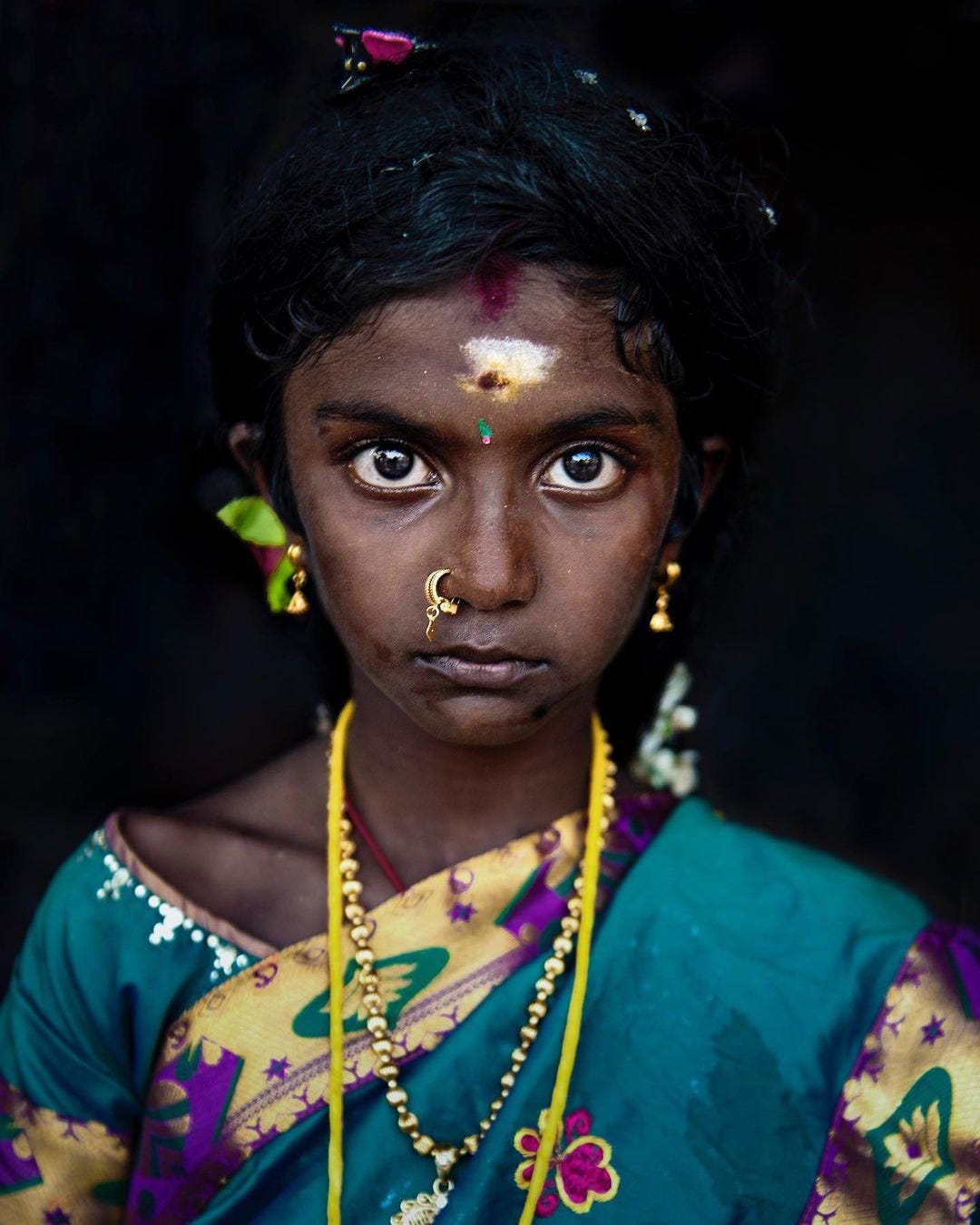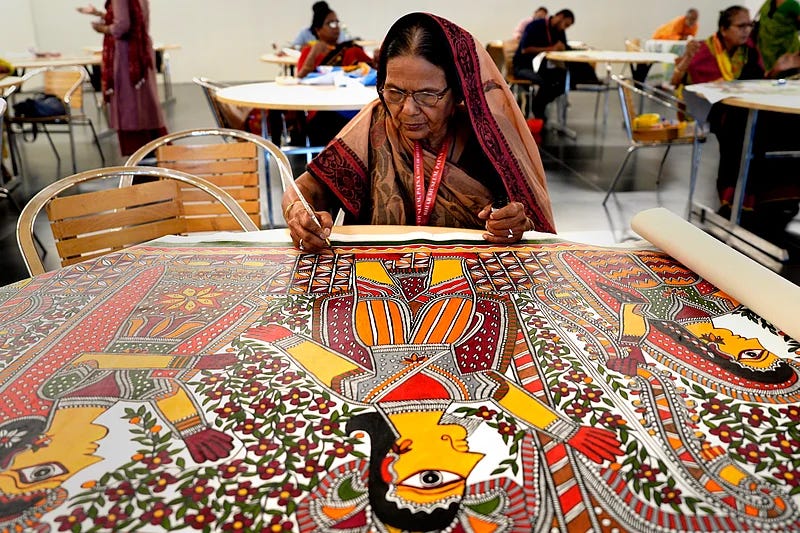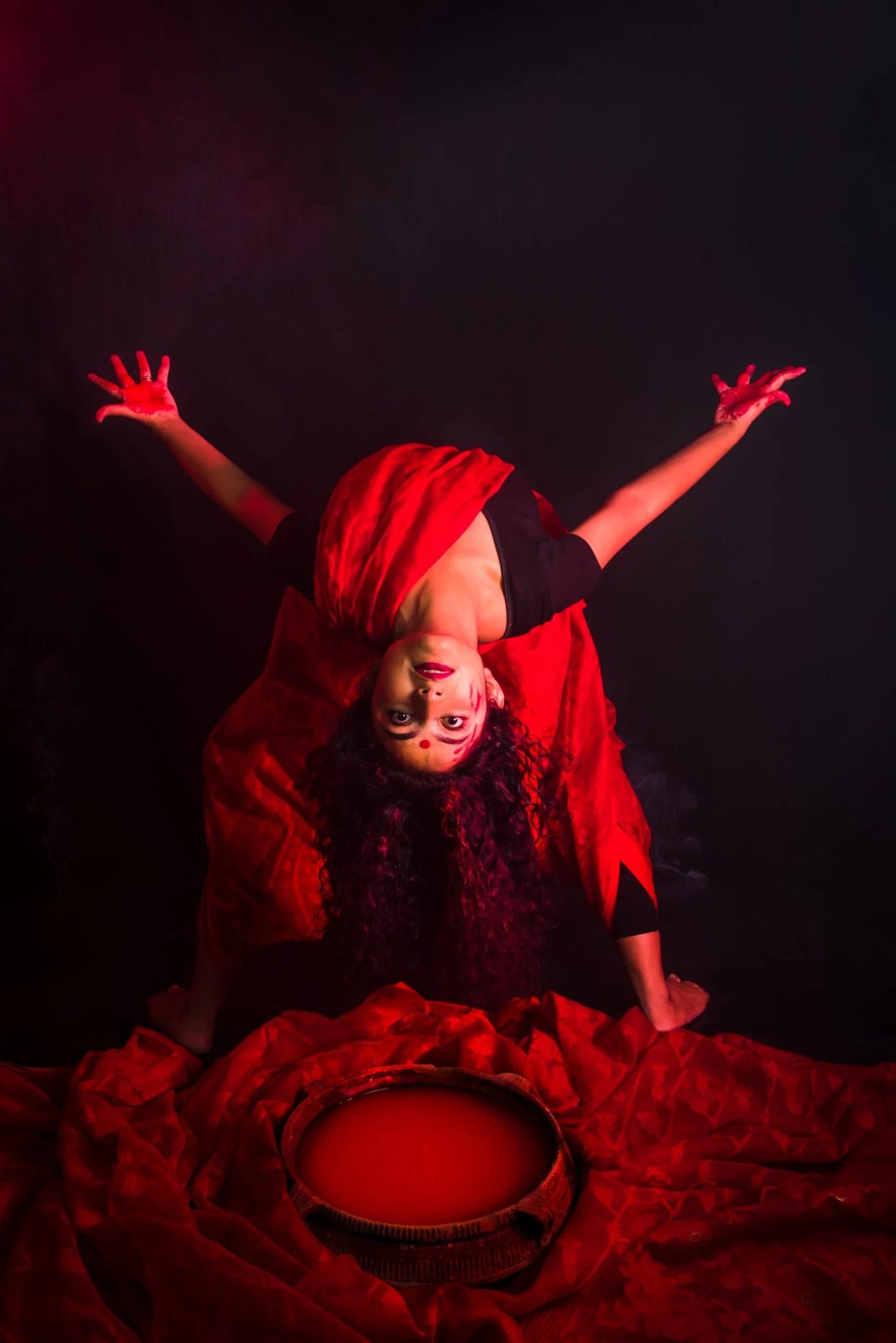Goddesses Caged by Myth and Misogyny
On Myth as Patriarchy’s Oldest Weapon - An essay from 'Berkana' author Swarnali Mukherjee
Disclaimer: This essay discusses themes of sexual violence, internalisation of trauma, systemic oppression, and cultural erasure. Some sections may be triggering. Please prioritise your mental and emotional well-being while reading or listening, and engage only in ways that feel safe for you.
I would like to begin by thanking Kate for her scholarly and necessary essay; Presupposing Patriarchy: History as Terrorism. Her words stirred something deep within me — an archetypal tale, a remembrance of women who vanished to convenience the patriarchal norms — their truth unspoken, their myth unbroken. This essay is an invocation, and also a conversation — an offering of solidarity and expansion on Kate’s brilliant premise. I’m grateful to Kate for creating a space where voices like mine can speak back to history and forward into transformation.
"If women had written the books, the facts would be different." – Christine de Pizan

Although I do not claim expertise in Indian mythology, I do claim the authority of having lived under its shadow. Like many South Asian women, I inherited myths not through scholarly discourse but through lullabies, textbook summaries, overheard evening television serials, and moral edicts disguised as bedtime stories. I speak here as someone whose earliest notions of femininity were shaped by women like Sita1 and Draupadi2—princesses cloaked in reverence yet bound by silence.
Even as a child, I remember feeling unease while listening to their tales. There was sympathy, of course, but there was also something else: a subtle-lingering despise, like the unspoken judgment society casts on survivors of violence. As I grew older, I recognized that feeling. It was the collective questioning of the victim’s choices that I carried on my impressionable psyche. It was this unease over the shattered illusions of safety, sanctity, and silence that made me question their truth. What was done to them felt wrong, and so did their silent acceptance. And yet, I now see it wasn't acceptance at all—it was a carefully designed narrative trap.
What Kate calls "historical terrorism" is as much enacted through myth as it is through written history. Even though myth relies more on oral traditions of storytelling, it is not inherently virtuous or innocent. Myth is the operating system through which patriarchy runs its most elaborate scripts.
The Female Agency Reduced to Justify War
Let us examine two mythic figures from two ancient Hindu epics —Sita the daughter of Earth from the Ramayana and Draupadi the daughter of fire from the Mahabharata. These women are routinely held up as moral exemplars, but closer scrutiny reveals that their stories were never theirs to begin with. They were stories about them, not by them.
Sita is remembered for her chastity, for successfully walking through fire to prove her purity. However, let us not forget the specifics of her trial — after being kidnapped by Ravana3 and held in Lanka, Sita, upon her return4 after about an year, is made to undergo an agni pariksha5—to prove that her body wasn’t defiled. This test, demanded by Rama6 to satisfy public speculation, was the moment of profound humiliation and betrayal for Sita. Later, when Sita announces her pregnancy, his advisors and subjects again question her purity. In response to which, Rama like the peoples’ king that he was, sends his pregnant wife to a permanent exile. She was forced to raise her twin sons alone in a forest. In the final act of Ramayana, Sita laments her woes to Mother Earth and seeks permission to die. Ultimately the Earth yields and cracks to her daughter’s pain. Sita falls through the cracks and disappears forever. Her silence and disappearance is often seen as submission to her cruel fate.
Draupadi, too, is remembered for being gambled away, like an owned property, by her husband Yudhishthira7 in a game of dice. The winner of the game, the Kauravas8, then saw fit to do with her as they pleased. Duryodhana9 unleashed the kind of brutality on her which is often glossed over in the retellings. She was dragged into the court by her hair, menstruating, abused, jeered at with inappropriate suggestions, and publicly disrobed in the presence of elders and gods. No one spoke for her. No one stopped the violence. Her body became the site upon which dharma was debated, her voice was nearly erased—except when she demanded vengeance, invoking a war between the two clans, that eventually consumed generations. She was eventually rescued by Krishna10, who conjured cloth endlessly to protect her. Even her salvation was divine, not human. Krishna then acted as the main adviser to the Pandavas, propelling them to fight the dharma war.
Both Sita and Draupadi are revered and pitied, never fully seen. They are caged survivors. Their pain is ritualized, sanitized, and recycled for consumption.
Kate writes, "When we presuppose male supremacy into the human experience, we make domination a condition of development." This rings painfully true in the case of these two women. Their mythology presupposes not just patriarchy, but its eternal moral necessity. It suggests that patriarchy, is closer to the divine order, and the only standing human institute that can bring justice. It enshrines domination as sacred ground to justify dharma war.
Unmaking of the Victim Princess

“As long as a woman cannot speak, as long as those to whom she speaks do not listen, the violence is unending.” ― Meena Kandasamy, When I Hit You
In Yuganta, the late feminist scholar Irawati Karve11 revisits Indian epics with anthropological precision and a piercing-modern lens. Karve resists the idealization of epic figures and instead presents them as human beings with political and psychological complexity. She writes of the wild, furious, and primal rage of Draupadi: "The Draupadi of the epic is not a sweet, self-effacing woman... she is strong, aggressive, and uncompromising." Karve positions Draupadi as a both a victim of male decisions and as someone who shapes the narrative through her anger and unwillingness to forgive, particularly in her demand for vengeance after the dice game. With Sita, Karve similarly dismantles devotional idealism. She observes how Sita's repeated trials are less about personal virtue and more about reinforcing the legitimacy of Rama’s rule. Her suffering becomes a tool to uphold the ideal king, which Karve sees as a strategic political maneuver cloaked in moral piety.
Volga12, in her feminist retelling The Liberation of Sita, makes that implicit critique explicit. Through a series of interconnected stories, she offers Sita alternate paths—ones that do not require obedience or return. In one story, Sita meets Surpanakha13, who, far from being a villain, becomes a bearer of wisdom. Surpanakha tells her, "We should stop waiting for men to recognize our pain. We must learn to heal ourselves." In another tale, Sita befriends Urmila14, who represents a different kind of strength—quiet, steadfast, and introspective. Through these encounters, Sita unlearns the script of martyrdom and gradually embraces agency and solidarity. Volga’s Sita is not an exile, she is a woman liberated from the expectations that once bound her. Her stories are both counter-myths and acts of reclamation.
Together, Karve and Volga offer a crucial feminist archaeology—Karve excavating the raw materials of myth, and Volga reshaping them into new possibilities. Both remind us that myth, like history, is always under revision—and that women’s stories are not afterthoughts.
The Architecture of Oppression
Why does this victim archetype endure? To answer this, we must ask who reaped the benefits by keeping these myths alive?
The victim-princess archetype helps consolidate patriarchal control. It gives moral cover to domination. The suffering woman becomes the emblem of purity; her pain — a prerequisite for societal balance. In turn, the oppressor is cast not as a villain — only as a necessary agent of cosmic order.
These mythic scripts are recursive algorithms. They write themselves into textbooks, rituals, marital vows, and even national politics. They are believed to the fault of radical acceptance—an ongoing, amnesiac retelling of the truth. What is worse is that they are so wilfully engraved in the body of the collective feminine psyche that violence against the female body becomes the norm, and silence becomes its volatile container.
This logic is not limited to India. Kate draws upon Harriet Jacobs' story to illustrate how narratives were shaped to normalize domination. Jacobs writes from a crawlspace, hidden yet watching. Sita too disappears into the Earth; Draupadi is disrobed in a court of silence. All three are made to suffer in spaces curated by men, under the guise of law, dharma, or fate.
Co-Creation of the Archetype
Here I must offer a difficult truth: the victim archetype is not only imposed — it is, sometimes, internalized. When women are denied access to power for long enough, submission can appear as survival. The story of the victim princess is one we are taught to identify with, even romanticize.
The blame cannot be shifted on the women. It is on the architects of patriarchy who have trained entire cultures to prefer obedience over resistance, purity over power. Yet, history always has its cracks. It is through these fractures into the architecture of myths, we see the glimpses of rage, subversion, and quiet rebellion. These are not weak women; they are volcanoes forced to whisper.
Toward Reclamation in Literature

What happens when women reclaim these stories? They destabilize the foundation of what is projected as necessary patriarchal cruelity. In retellings by writers like Githa Hariharan15 (The Thousand Faces of Night) and Chitra Banerjee Divakaruni16 (The Palace of Illusions), we find Draupadi as philosopher and Sita as seeker.
Hariharan reimagines myth through intimate, intergenerational narratives where women’s desires, anxieties, and quiet rebellions take center stage. Her protagonist Devi is shaped by mythological inheritance and by women's tales that break the mould of the 'ideal woman'. In one scene, Devi listens to her grandmother's stories and realizes that mythology can be both cage and key: "I learnt my first lessons in love and betrayal from the women who knew how to endure, and how not to forget." Here, mythology rejects the old doctrine and becomes oral resistance.
Divakaruni, on the other hand, offers Draupadi a voice so urgent that it reshapes the epic. In The Palace of Illusions, Draupadi narrates her life with fierce introspection: "I was born of fire, and yet I craved love." The retelling in that sense is a reclamation. Draupadi, in Divakaruni’s world, is so much more than the wronged queen. She is a woman aware of her symbolic use in political games and male ego. She dares to ask questions the original epic leaves unanswered, challenging fate and critiquing war.
In these worlds, the victim has surpassed her passivity to transcend to a role of a narrator, a decision-maker, an author of her own becoming. These retellings are radical because they reject the patriarchal gaze and instead foreground a woman's consciousness—complex, flawed, yearning, and powerful.
To retell a myth is to wrestle power from its original narrators. Kate writes, "To maintain that there is but one authoritative voice... is to assert superior/inferior intellectual abilities between communities of humans." The retellings by Indian feminists fracture that authority.
Mythic Aftershocks
The impact of these ancient stories is not confined to books or temple walls. It bleeds into everyday life. Into the way women are taught to forgive abuse. Into courtrooms where marital rape is not recognized.17 Into families where daughters-in-law are told to be obedient and self-sacrificing like Sita. Myth is not history. It is precedent.
To call it mere tradition is to excuse the damage it perpetuates. But myth can also be medicine. If reimagined. If reclaimed. If rewritten.
Final Notes
This essay is written from a place of emergence. I have known silence, I have known betrayal, and I have witnessed how myths can be used to shrink women down to symbols. Retelling of the wound helps in fading the scar. I am not defined by what was done to me. I am defined by the way I refused to disappear.
Unlike Sita, I do not vanish into the Earth. Unlike Draupadi, I do not wait for divine justice. I choose to speak, like Harriet Jacobs did — to remember, to reclaim, to tell truth in my own voice.
To echo Kate: "When we presuppose male supremacy into the human experience, we make domination a condition of development." Similarly the terrorism of myth lies both in what was done and what is still chosen to be told.
Therefore, let this essay be a disruption. Let it be a myth unmade.
A prominent Hindu goddess and the female protagonist of the epic Ramayana. Born out of Earth, she was the princess of Mithila kingdom. She was also the consort of Lord Rama. Sita is revered as a symbol of wifely devotion, self-sacrifice, and purity
Draupadi, a central figure in the epic Mahabharata, was a princess of Panchala, born from a fire sacrifice, hence her name Yagnaseni. She became the common wife of the five Pandava brothers, a unique situation in the epic, and her humiliation during a dice game sparked the Kurukshetra war
A ferocious ten-headed demon, king of Lanka
Rama waged a holy war against Ravana who kidnapped his wife, and eventually won. He brought Sita back to his Kingdom of Ayodhya post war
Trial by Fire. Sita was made to endure the flame as a test of her sexual purity. If she failed the test, she would have been consumed by the fire, which the myth implies rightly serves a defiled woman — a victim
Rama the crowned prince and later the king of Ayodhya dynasty
A central character in the Indian epic, the Mahabharata. The Eldest of the Pandas
High clan and cousins to Pandavas
Eldest Kaurava prince
One of the prime deities in Hindu Pantheon
Irawati Karve was an Indian sociologist, anthropologist, educationist and writer from Maharashtra, India
Popuri Lalita Kumari is a prominent Tamil poet and feminist writer
She was the sister of Lanka's king, Ravana who has been wronged by Lakshmana (Rama’s brother) who cut her nose for teaching her a lesson when she tried to seduce him
Wife of Lakshmana. Also known as goddess of sleep
Writer and Editor, winer of Commonwealth Writers' Prize for the best first novel in 1993
Chitra Banerjee Divakaruni is an Indian-born American author, poet, and the Betty and Gene McDavid Professor of Writing at the University of Houston Creative Writing Program.
India is one of the few countries where marital rape is not explicitly criminalized. Exception 2 to Section 375 of the Indian Penal Code states that non-consensual sexual intercourse by a man with his wife is not rape, provided the wife is over the age of 18 (the age was raised from 15 in a 2017 ruling). This legal exception has been the subject of ongoing and intense debate in Indian courts.












Wow. Thank you for offering this work and skill.
This is such a strong and important piece. I teach in an International School, and an assignment for Yr 9 students was how to use Drama in a social context. A group of Indian students took the story of Sita, and used it as an "allegory" to comment on domestic violence. So your essay really hit home for me. It's what Angela Carter did too, isn't it, with her re-imaginings of fairy tales. Thank you for posting!